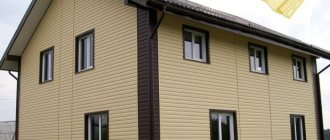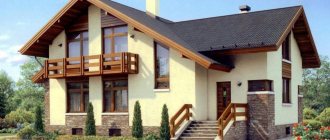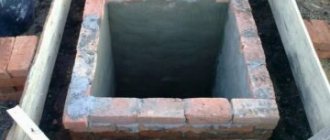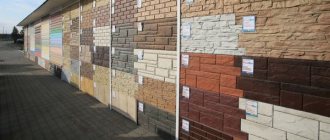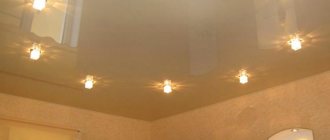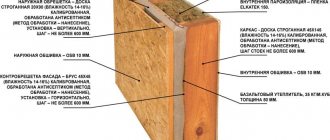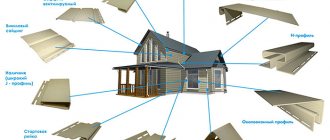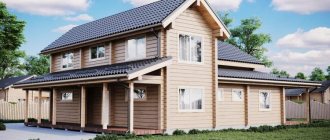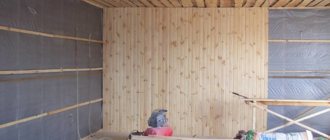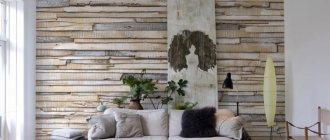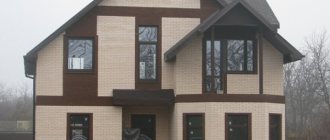Most owners of individual houses and cottages strive to create an original appearance for their home.
Modern manufacturers present a huge range of different finishing materials that are designed specifically for such purposes.
You can finish the facade of the house yourself, or you can turn to master finishers for help.
Types of finishing materials for facade cladding
Nowadays, choosing the appropriate option for facing building materials is not difficult.
- Plaster.
- Facing brick.
- Siding.
- Natural or artificial stone.
- Thermal panels.
Having chosen the material, all that remains is to study in detail how to make a high-quality and beautiful façade of a house with your own hands.
Home finishing options
There are a lot of materials for exterior home decoration. Even more façade designs. But there are only two ways to attach the cladding. And there are only two types of facades. They differ in the installation principle.
Mounting options:
- Wet facade. This option involves the use of a sticky mixture, due to which the cladding is held on the walls.
- Dry. Tiles, panels or other building materials are secured with metal fasteners - self-tapping screws, nails or screws.
Decorative
There are finishing materials that have only one function - decorative. They do not protect, do not insulate or smooth out noise; their task is to decorate the walls.
Decorative plaster was once the most expensive finishing material. Today, ingredients are added to mixtures to increase their strength.
Types of decorative plaster:
- fur coat – contains marble chips;
- Venetian - imitation marble;
- pebble – contains large grains of marble;
- flock - due to the dye particles, the surface looks velvety.
Combined finishing
Several types of finishing are used to decorate the facades of country houses. Combine no more than two materials. The number of colors is not limited. Not all materials can be combined. The proximity of metal and wood is unlikely to be successful.
Plastering
This method of cladding the facade of a house allows you to perfectly disguise all the shortcomings and shortcomings that appear on the surface during the operation of the building.
In the process of facing work, you must strictly follow all the recommendations of experienced specialists and accurately follow the technology for laying the material.
When selecting suitable materials, you should give preference to ready-made compositions intended for plastering various surfaces.
In the production process of such compositions, manufacturers use special additives that significantly increase the service life of the coating.
Varieties of mixtures for plastering facades
Mineral mixtures. The main component of such compositions is cement. To achieve elasticity and resistance of the coating to aggressive environmental conditions, manufacturers use various additional components.
Check it out here too!
DIY illuminated ceiling: 85 photos of the best options! Types of lighting: spots and features of their connection, LED backlight, diode backlight, “starry sky”Assembling a shower cabin with your own hands: assembling the tray, preparing and installing the walls, installing the portal. All stages of assembly with photos
How to make ventilation with your own hands - we ensure freshness in the house, create comfort yourself (photo + video)
Acrylic compositions. The main component of such mixtures is acrylic or polyvinyl. This coating is highly resistant to moisture. However, under the bright rays of the sun, the coating quickly loses its original color.
Silicone compounds. This coating has increased resistance to temperature changes, exposure to various precipitation and ultraviolet rays.
Despite the presence of a large number of advantages, such a coating also has one significant drawback - high cost.
Review of materials for exterior cladding of a cottage
It is necessary to select external materials for cladding and cladding of a building depending on the original material of the walls. Let's consider all the options one by one.
Various materials
For a stone house
To sheathe a brick house or cinder block cottage, you can use different materials. As a rule, such buildings have a strong foundation and do not require reinforcement for cladding.
Siding - an economical option
You can cheaply cover the outside of your house with siding. Moreover, you can take models from fiber cement, metal and plastic. Thin long panels are easily installed according to the principle of conventional laminate (groove to groove). As a result, the finished walls have the appearance of a continuous decorative canvas. The master has the opportunity to choose any shade of finishing for his home. Fortunately, there are a lot of siding color options.
Siding must be installed on the sheathing. For a stone house, it is better to assemble it from a galvanized steel profile.
Facade clinker brick
These are original brick panels made from various refractory clays, glaze and water. Clinker brick is especially suitable for buildings made of aerated concrete or cinder block. They can also decoratively decorate window openings filled with blocks. The weight of the tiles is moderate, so the foundation of a stone house can withstand it.
Clinker tiles can also imitate the look of natural stone, etc. The material is not afraid of fire, water, or temperature changes.
Facade plaster
One of the inexpensive ways to sheathe a stone building. They are classified as wet. Insulated plaster enhances the heat and sound insulation of the house and protects the walls from the effects of precipitation.
In your work you can use the following types of facade plaster:
- Mineral. Made from a mixture of cement and sand. Withstands temperature changes and various mechanical loads. Resistant to fading.
- Silicone. One of the most expensive types of facade plaster. Silicone resins have been added to the composition. Due to this, the dried plaster becomes very strong and at the same time elastic. Walls finished with it do not absorb or allow water to pass through. The color lasts forever and has not been exposed to sunlight.
- Acrylic. The name speaks for itself. Acrylic has been added to the composition. As a result, the dried finished walls have an upper protective film. That is, the finished building reacts completely calmly to dirt, moisture, and dust. The walls can be washed. Acrylic facade plaster has only one drawback - low vapor permeability due to the acrylic film.
Facade paint
This finishing option is suitable if the house as a whole is strong and the level of thermal insulation suits the craftsmen, but the brick itself has lost its beautiful initial luster. The peculiarity of facade paint is that a special structuring filler is added to its composition. That is, when applying the material to the walls, it evens out errors. The paint is applied in a layer of 10 mm. Thus, we obtain both decorative and protective wall finishing at the same time. The master can choose any shade of facade paint.
Brick
Brick walls are very strong and reliable. Do-it-yourself facades of private houses, lined with bricks, look very original and respectable.
Check it out here too!
- How to make an arch from plasterboard: we make an interior arch according to photo instructions. 120 photos of arches in the interior
How to make a balcony with your own hands - tips on how to make a balcony in an apartment beautiful. Step-by-step guide to the use of modern building materials + 70 photos of the best design options
Installing a compartment door with your own hands - step-by-step instructions for installing sliding doors and tips on choosing fittings (110 photos + video)
During the work process, you can use bricks of different colors and shades. In addition, the masonry method can also be any. This opens up wide opportunities for the implementation of any design ideas.
In the process of finishing work, it is very important to strictly follow the technology.
Siding
Currently, this type of cladding is quite popular and in demand. There are many advantages of this coating:
- Light weight;
- Rich color palette;
- Affordable price. This option of cladding the facade with your own hands will cost its owner much less.
- Simple and quick installation;
- Excellent technical characteristics.
A natural stone
This coating looks luxurious and reliable. However, before purchasing such finishing materials, you must take into account that they are quite heavy.
Therefore, you first need to assess whether the foundation will withstand such heavy loads. If necessary, walls and foundations should be strengthened.
Finishing a facade using such material requires certain skills and experience. It is much simpler and easier to cladding the facade using an artificial analogue.
Check it out here too!
Do-it-yourself countertop installation: selection, installation and fastening of the countertop. 155 photos of the best ideas and tips for their useDo-it-yourself canopy - beautiful ideas, best projects and tips on how to build a canopy with your own hands (90 photos and videos)
Do-it-yourself siding installation: stages of the work, step-by-step instructions for installing the siding and secrets of choosing high-quality siding (125 photos and videos)
This coating has excellent technical characteristics and is practically no different in appearance from natural stone.
In addition, the weight of such material is much less and the cost is much lower.
Influence of architectural style
It is believed that the facade is the face of the house. The choice of finishing material for facades is made taking into account the style in which the cottage or country house is built.
Country
This direction combines several styles at once - cowboy, Provence, English and rustic.
Natural shades are used to decorate country-style facades. Houses are finished with plaster or decorative stones. Sand, brown and terracotta colored siding is used.
Provence
The Provence style originated in France, its main color is white. The bright buildings look extremely fresh. This style is especially popular in coastal and resort areas where there is a lot of sun.
Facing for Provence style:
- brick;
- tile;
- stone;
- tree.
On a note!
For cladding cottages in the Provence style, only light shades are used. Iridescent surfaces are especially appreciated.
Chalet
This option is rarely used in urban areas. Chalet is a style for country houses built in a beautiful area. The chalet is especially in harmony with green grass, shrubs and trees. Preference is given to warm tones.
Two-story cottages are often built in the chalet style. Usually the first floor is built of stone or brick, the second floor is made of wood. The main object of work is the second floor, which has wooden beams and attics. Wood is usually plastered and then painted.
English
Buildings in this style are strict and aristocratic. Their facades are discreet and reliable. It is recommended to decorate the façade with red brick. Combinations with decorative stones and white bricks are possible. No additional decor is used.
Thermal panels
Currently, owners are increasingly using thermal panels to decorate the facades of various buildings.
Such a coating simultaneously performs two functions: insulating the house and improving the appearance of the structure. This is due to the characteristics of this material and the structure of the panels.
The advantage of such a coating is durability, practicality, and resistance to temperature changes. In addition, finishing the facade with your own hands using this material is quite simple.
Making a beautiful house facade with your own hands is very simple. To do this, you just need to choose the appropriate option and study the technology of its installation.
Ventilated facades
This is a complex multilayer system. A small gap is left between the walls and the finish. Ventilation prevents the growth of fungi. All variants of wet facades are unventilated.
For ventilated versions use:
- Metal panels with polymer coating. Disadvantage: high thermal conductivity. Insulation helps eliminate it.
- Wood. It is coated with a fire retardant, antiseptic and water repellent.
- Porcelain tiles, natural and artificial stone.
- All types of siding.
Photos of house facades with your own hands
Read here - How to cover a house with siding with your own hands - updating the facade, secrets and advice from the experts, step-by-step instructions (photo + video)
